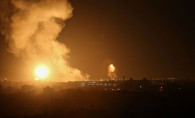Israel’s separation barrier: 20 years of confining Palestinian freedom
Israel’s separation barrier: 20 years of confining Palestinian freedom
At the peak of the second Palestinian uprising (intifada) in 2002, Israel decided to build a barrier wall to protect itself from suicide bombings and to prevent attackers from crossing into Israel from the West Bank.
Twenty years after Israel’s cabinet approved the construction of a “separation barrier”, and despite the International Court of Justice deeming in 2004 that the barrier violates international law, the Israeli barrier is still harshly limiting Palestinians’ freedom of movement and is contributing to the fragmentation of Palestinian life, according to ReliefWeb.
It is reported by AP that about 100,000 Palestinians legally cross the barrier through checkpoints to go to work. The UN estimated that 150 Palestinian communities own farmland west of the barriers, inside the West Bank, while about 11,000 Palestinians need Israeli permits to be allowed to stay in their homes, which fall in the so-called Seam Zone, sections of Palestinian land within the occupied Palestinian territory, which is located between the illegal Israeli Annexation Wall and the 1949 Armistice Line (Green Line).
To live within the Seam Zone, Palestinians have to apply to the Israeli Civil Administration for a “permanent resident ID” so that they can keep their own land. They have to go through checkpoints and a permit regime, a procedure that controls their movements and hinders their day-to-day activities. There are 101 different types of permits “governing” Palestinian movement that allow Palestinians to move within the West Bank, between the West Bank and Israel, between the West Bank and other parts of the occupied Palestinian territories, or beyond internationally recognized borders, according to the UN.
Moreover, Israel is currently encouraging Jewish citizens to build and expand settlements on both sides of the barrier. About four-fifths of the approved barrier route runs inside the West Bank, trespassing the pre-1967 border and linking it to illegal Israeli settlements, ReliefWeb reported.
AP reported that Israel has begun constructing a new 45-kilometer-long and 9-meter-high barrier last week in the northern West Bank to replace a security fence.
It is worth noting that high barriers can be seen throughout Jerusalem, Bethlehem and other urban areas, while in rural areas, they are constructed of random wire fences with CCTVs, according to AP.







